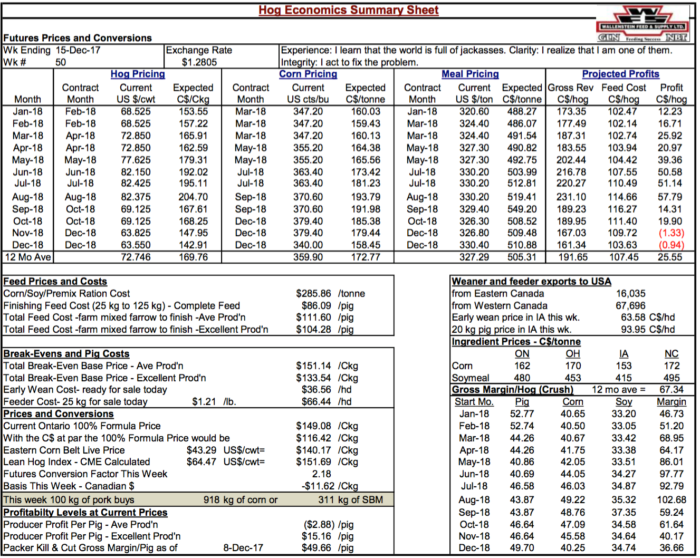
Canada – The Challenges of Labor
As I visit with producers the conversation, sooner or later, and mostly sooner, turns to labour. The challenge of finding employees, motivating them, retaining them etc. There seems to be an ever-dwindling pool (at least domestically) of workers inclined to work in pig barns, particularly sow barns. This is also a refrain I here from livestock haulers to meat packers.
The pool that all these industries fished in, farm kids has become increasingly shallow. This recent newspaper article on a study done by the University of Guelph further highlights the challenges.
Agri-food article:
With four Ontario jobs for every college graduate, employers face huge challenges in the Southwest’s vast farm belt
By Laura Broadley, St. Thomas Times-Journal, Monday, October 23, 2017
In Ontario’s largest industry, it’s about as close as it gets to saying the jobs are growing on trees.
The downside?
Those jobs, many of them in Southwestern Ontario, are going begging for bodies — a trend that’s only expected to get worse.
A new report by Canada’s largest agricultural school says there are four jobs for every one of its graduates in the agri-food sector, a vast industry that extends from the family farm to giant food processors like those London has worked hard to land in recent years as it builds am industrial hub feeding off one of the nation’s richest farm belts.
The bottom line?
There’s growing worry Southwestern Ontario won’t be able to fill its own jobs in the burgeoning industry, forced instead to look elsewhere not just for labour, as many producers do now, but also the brain power the wider industry needs.
“I was just in a plant just last week in Moncton (New Brunwwick) and 75 per cent of the workers in that plant weren’t born in Canada. So, that’s the reality you would find anywhere in Canada including southern Ontario,” said Sylvain Charlebois, a food-industry expert formerly with the University of Guelph, whose Ontario Agricultural College painted the picture of the challenges ahead in a recent report.
The food industry was already under pressure to lay its hands on enough employees, Charleobois said, no matter how many graduates schools pump out.
The Guelph-based college, with a campus in Ridgetown in Chatham-Kent, has increased its enrolment by 30 per cent over the last five years with a 50-per-cent surge in students in key areas such as its bachelor of science in agriculture program.
It’s a good time to be entering Ontario’s food and agriculture sector.
In fact, there are currently four jobs for every graduate of the University of Guelph’s Ontario Agricultural College (OAC), according to a new “Planning for Tomorrow 2.0” report commissioned by OAC.
Based on a survey of 123 Ontario employers in the sector, the report provides a snapshot of hiring trends and demands in food and agriculture. The new survey updates a previous Planning for Tomorrow report from five years earlier. Synthesis Agri-Food Network, in collaboration with Orion Global Business Sustainability Consultants, conducted the new study.
Key Findings of the Report
- Today there are 4 jobs for every OAC graduate entering Ontario’s food and agriculture sector.
- 44% of food employers and 56% of agriculture employers surveyed project a general increase in the average number of new hires over the next five years.
- 77% of food employers and 79% of agriculture employers have a preference for formal training in food and agriculture graduates.
- 50% of food and 57% of agriculture employers surveyed stated that more than half of their employees require or have post-secondary education.
- 51% of food respondents and 67% of agriculture respondents reported difficulties in finding recruits.
- Surveyed employers communicated a strong demand for co-op programs and experiential learning.
Read here the “Planning for Tomorrow 2.0” report commissioned by OAC.
It seems producers will have to look increasingly as many already are to foreign workers to fill their needs at least at the production level. However I believe they will have to look even more to mechanization and technology to replace labour wherever possible, especially on the drudgery jobs. Finding people that want to hang onto the end of a pressure washer for extended periods of time is likely to be an endless search. The dairy industry appears to have made massive strides in what was a very labour intensive industry with such technology as robotic milkers and such mechanization as large bales. It appears that the pork industry will need to further pursue similar solutions.
As we close out the year though it is also good to consider our blessings as much or more than we consider our challenges. First of all we’re blessed to live in a free and prosperous country without any war or strife impeding our progress or daily life. Here in Ontario although some producers seemed slightly disappointed with soybean yields seems most producers I spoke to were more than pleasantly surprised with corn yields. Many suggested perhaps their best corn crop ever. Much to be thankful for.
Hog profitability although tempered in the six weeks since my last commentary, it is still more than reasonable given the time of year. Here courtesy of Bob Hunsberger, Wallenstein Farm Supply. Projected profits currently for the next 12 months are $25.55 on average, which has to be viewed as encouraging given our unprecedented period of profitability.
Categorised in: Featured News, Global Markets
This post was written by Genesus



